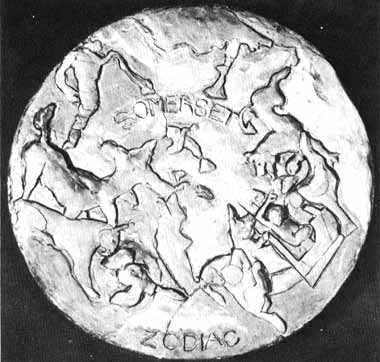John & Katharine Maltwood Collection
| View the Collection |
History of the Collection |
John & Katharine Maltwood |
Information Resources |
The Maltwoods Introduction
Katharine Maltwood Biography
Early Sculpture
Post-War Works Glastonbury Zodiac - Arthurian Mythology - Discovering the Zodiac - Theory of the Zodiac - Earning Recognition - Ties to Freemasonry - Chilton Priory Life in Victoria, B.C. Monograph (pdf 1.14 MB)
About Us Contact Us Visit Us Site Map

The Glastonbury Zodiac - Part 2: Discovering the Zodiac | ||
|
The text Katharine Maltwood referred to in tracing the locations and events of the quest was The High History of the Holy Grail, a Norman-French manuscript translated into English in 1910 by Sebastian Evans for Dent's Everyman edition. Although the original author is not known, he was apparently well acquainted with the Glastonbury area since he clearly describes the local terrain and mentions Glastonbury Abbey as the source of his tale. It was while using this text to make a map of the itinerary of the adventures of Arthur in the Vale of Avalon that Katharine Maltwood came to believe the giant creatures with which the knights battled actually existed in the form of massive earthworks laid out in a circular pattern some ten miles in diameter. She later recalled the discovery: "I shall never forget my utter amazement when the truth dawned on me that the outline of a lion was drawn by the curves of the Cary river below the old capital town of Somerset. So that was the origin of the legendary lion that I had been questing! A nature effigy and a god of sunworshippers! Leo of the Zodiac ... Obviously, if the lion was a nature effigy then the dragon, griffon and the giants etc., must be likewise; perhaps this was the most thrilling moment of my discovery."50
Further investigations revealed the giant effigies of Orion, the Ram, the Fishes and the Phoenix. Her map showing these together with the supposed sites of the Arthurian tales was published as a supplement to the 1929 edition of The High History of the Holy Grail. Later she claimed the remaining figures were distinguished, the whole forming an ancient zodiac of the constellations. She arrived at the hypothesis that the knights were actually hunting nature gods and that they themselves "were the Christian reincarnations of the gods they quested ...Sir Lancelot showing all the characteristics of the Lion, King Arthur of the sun-god Hercules, Sir Gawain of the Ram etc."51 Katharine Maltwood used several sources to reconstruct the precise outlines of the giant effigies. In addition to tracking the countryside and seeking out the descriptions in Arthurian literature she consulted numerous large-scale ordinance survey maps together with pictured astronomical figures from all parts of the world.52 In the 1930's she ordered a series of air photographs to be taken and later contracted Hunting Aerosurvey's Ltd. to carry out a large-scale aerial survey. The effigies, modelled in partial relief are apparently delineated by hills, earthworks, mounds, artificial waterways, old roads, footpaths, streams and rivers. She claimed that when a modern planisphere is placed on the back of a diagram of the effigies the different constellations fall, for the most part, on the appropriate zodiacal figures, proving the solar nature of the temple. She insisted the whole conception was astonishingly skillful, some of the figures measuring up to two or three miles in length and all but one arranged with their heads turned towards the sun, setting in the west. She also pointed out that in order that the design should fit the dome of the sky and the twelve zodiacal divisions of the calendar, with their corresponding stars, the figures were made to contract towards the centre of the circle of signs. The zodiac or agricultural calendar is described more fully in her articles and books:
Thus Katharine Maltwood reached the conclusion that the figures which create this Temple of the Stars explain symbolically the processes of nature brought about by the sun's seasonal pageant of death and rebirth. She believed these pre-Christian stories of the stars were adopted by later chroniclers and interwoven with the Christian Grail legend.
All content on this page is copyright © 30 January, 2006 |
||
